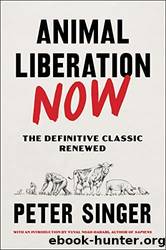Animal Liberation Now: The Definitive Classic Renewed by Singer Peter

Author:Singer, Peter [Singer, Peter]
Language: eng
Format: epub
Tags: ST, Ethics, Politics, Science, CS, Philosophy
ISBN: 9780063226708
Amazon: 0063226707
Goodreads: 62119780
Publisher: Harper Perennial
Published: 2023-01-01T08:00:00+00:00
D O W N O N T H E F A C T O R Y F A R M
141
teriors of confinement houses.1 16 At the Oregon State University Rabbit Research Center, researchers have developed a cage system for rearing rabbits and are experimenting with stocking densities of two rabbits per square foot.1 17 In Australia, selected sheep producing superfine wool have now been brought indoors in individual and group pens-the aim being to keep the fleece clean and long. Wool from these sheep sells for five or six times the usual price. 1 18 Although the fur trade likes to emphasize its
"ranch-raised" furs to minimize the bad publicity it gets from the trapping of wild animals, fur "ranches" are highly intensive.
Mink, raccoons, ferrets, and other fur-bearing animals are kept in small wire cages. The beautiful arctic fox, for instance, normally ranges over thousands of acres of tundra: on a fur farm it has a wire cage measuring forty-two by forty-five inches.
We have now surveyed the main trends in animal ra1smg in which traditional methods have been transformed into factorystyle animal production. Sadly, as far as the animals are concerned, there has been very little improvement since the first edition of this book was published fifteen years ago. At that time it was already clear that modern production methods are incompatible with any genuine concern for the welfare of the animals.
The evidence was first compiled in Ruth Harrison's pathbreaking book, Animal Machines, published in 1 964, and was authoritatively supported by the Brambell committee, a committee appointed by the British minister of agriculture that consisted of the best qualified experts available. In addition to Brambell, himself a noted zoologist, the committee included W. H. Thorpe, the director of the department of animal behavior at Cambridge University, and other experts in veterinary science, animal husbandry, and agriculture. After a thorough investigation, in 1965
they published an eighty-five-page official report. In the report, the committee firmly rejected the argument that productivity is a satisfactory indication of the absence of suffering-the fact that an animal is putting on weight can, they said, be a "pathological condition." They also rejected the view that farm animals don't suffer from confinement because they are bred for it and are used to it. In an important appendix to the report, Thorpe stressed that
Download
This site does not store any files on its server. We only index and link to content provided by other sites. Please contact the content providers to delete copyright contents if any and email us, we'll remove relevant links or contents immediately.
The Lonely City by Olivia Laing(4752)
Animal Frequency by Melissa Alvarez(4400)
All Creatures Great and Small by James Herriot(4239)
Walking by Henry David Thoreau(3898)
Exit West by Mohsin Hamid(3779)
Origin Story: A Big History of Everything by David Christian(3652)
COSMOS by Carl Sagan(3560)
How to Read Water: Clues and Patterns from Puddles to the Sea (Natural Navigation) by Tristan Gooley(3410)
Hedgerow by John Wright(3280)
The Inner Life of Animals by Peter Wohlleben(3264)
How to Read Nature by Tristan Gooley(3255)
How to Do Nothing by Jenny Odell(3237)
Project Animal Farm: An Accidental Journey into the Secret World of Farming and the Truth About Our Food by Sonia Faruqi(3179)
Origin Story by David Christian(3149)
Water by Ian Miller(3130)
A Forest Journey by John Perlin(3029)
The Plant Messiah by Carlos Magdalena(2885)
A Wilder Time by William E. Glassley(2821)
Forests: A Very Short Introduction by Jaboury Ghazoul(2793)
